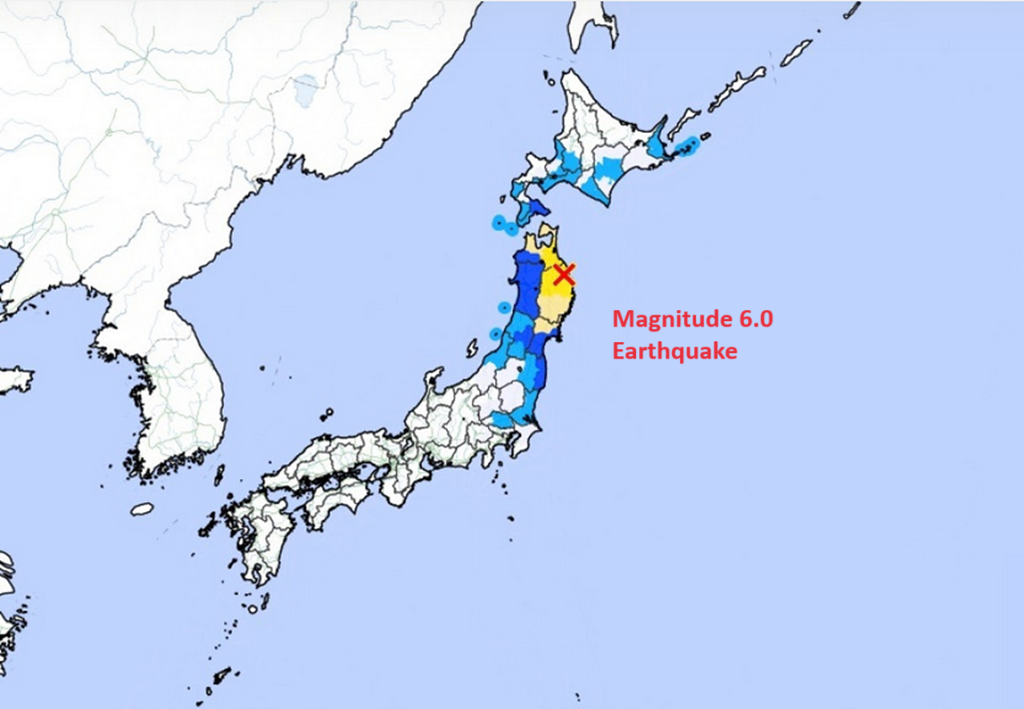An earthquake with a preliminary magnitude of 6.0 rattled northern Japan early Tuesday, according to the weather agency. There was no tsunami warning issued, although there were reports of minor injuries.
According to the Japan Meteorological Agency, the earthquake at 4:24 a.m. scored a lower 5 on the Japanese seismic intensity scale of 7 in locations including Hachinohe and Misawa in Aomori Prefecture, as well as Miyako and Kuji in Iwate Prefecture.
A woman in her 70s was transported to the hospital in Hachinohe after falling out of bed and injuring her left wrist, while a woman in her 80s damaged her head when she fell while standing up, according to local firefighters.
There have been no recorded injuries in Iwate Prefecture.
The agency warned that earthquakes with seismic intensities in the low fives could last for approximately a week in impacted areas.
The temblor measured 4 in several other parts of the two prefectures, including Higashidori, Morioka, and Hanamaki, as well as Kesennuma in Miyagi Prefecture, according to the report.
The earthquake’s epicenter was located in northern Iwate Prefecture at a depth of approximately 71 kilometers, according to the agency. It previously stated that the preliminary magnitude was 6.1, with an 80-kilometer focal depth.
According to Tohoku Electric Power Co., no irregularities were observed at the Onagawa or Higashidori nuclear power facilities in Miyagi and Aomori prefectures following the earthquake. Neither plant was operational at the time of the earthquake.
Japan Nuclear Fuel Ltd. stated that the earthquake had no effect on the operation of its reprocessing plant in Rokkasho, Aomori Prefecture.
Japan experiences earthquakes more frequently than most other places on the planet, owing to its location on the Pacific “Ring of Fire,” a seismically active region.
This implies that people there are accustomed to earthquakes and rumbles. Some earthquakes, such as the disastrous 2011 Tohoku earthquake and tsunami, continue to cause significant damage and loss of life.
Japan has a comprehensive disaster response system in place, including tight building rules and life-saving early warning alerts.
Despite this, the unpredictable nature of earthquakes keeps everyone on their toes, demonstrating how difficult it can be to live in one of the most earthquake-prone areas in the world.
North Korean ballistic missile, lands outside Japan’s EEZ
On Tuesday, North Korea launched a ballistic missile into the Sea of Japan, and the projectile landed in waters outside Japan’s exclusive economic zone, according to the Japanese Defense Ministry.
The missile was launched northeasterly from North Korea’s west coast at 6:52 a.m., flying about 650 kilometers at a maximum height of around 100 kilometers, according to the ministry. There were no reports of damage to aircraft or vessels.
The South Korean military said that the North fired what seemed to be an intermediate-range ballistic missile into the Sea of Japan. It detected a missile launch from near Pyongyang at 6:53 a.m.
The Japanese government objected to North Korea, Prime Minister Fumio Kishida said, adding that the country’s ballistic missile tests violate UN Security Council resolutions.
“This is a matter that affects not just our country’s security, but also the safety of the region and the global community. “It is completely unacceptable,” Kishida told reporters in the prime minister’s office.
Japan would collaborate with the United States and South Korea to protect the safety and security of people in the region, he stated.
It is North Korea’s first ballistic missile launch since March 18, when Tokyo detected three short-range missile launches and North Korean leader Kim Jong Un reportedly watched fire drills utilizing “super-large multiple rocket launchers.”






